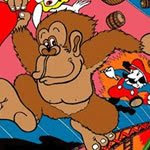
Back in 1982, Donkey Kong was on top of the video game world. Nintendo had firmly put their foot in the North American video game market with the addictive arcade game. Donkey Kong was featured in breakfast cereals, Saturday cartoons, and a board game. Despite this success, Nintendo was still a small company and found themselves up against Universal Studios involving a lawsuit over a trademark violation of King Kong. The Universal vs. Nintendo court case was a major turning point for Nintendo as a company, and was an inspiration around the world for other small companies. Nintendo took on a giant...and won.
The year is 1981. Arcades are a big business, and Nintendo has just released Donkey Kong, the brainchild of Shigeru Miyamoto. During this time, Tiger Electronics (the creators of those handheld games you usually find at Wal-Mart) took notice of Donkey Kong and how great of a game it was. Inspired, they developed a game based on King Kong as a handheld. As is standard in creating a product, Tiger Electronics contacted Universal about making licensed King Kong games as handhelds. The only other active license at the time was with a company that made King Kong costumes. Universal did a trademark report on King Kong and found little. This was all standard procedure and nothing seemed out of the ordinary. Universal granted Tiger Electronics the license in September of 1981, completely unaware of Donkey Kong.
The following year, Universal performed another routine trademark report. This time Donkey Kong came up because Nintendo and Coleco were trying to reach an agreement for a cartridge license of the game. The trademark report still saw nothing suspicious, and dismissed Donkey Kong. Sid Sheinberg, however, president of Universal Studios, had other plans. Sheinberg and his lawyer, Robert Hadl, tested a Donkey Kong machine and thought it infringed on King Kong. Universal wanted in on the video game industry. Warner had recently purchased Atari and Sega with success, so why not Universal? They already had much success in the movie and music industry. To get in, Sheinberg would use his copyright case against Coleco…

Sheinberg invited Arnold Greenberg, president of Coleco to California to meet. Greenberg assumed the meeting was about a potential venture with the two companies but instead, Sheinberg confronted Greenberg about Donkey Kong. Sheinberg stated “we are going to sue you if you don’t give us some kind of royalty on Donkey Kong.” This was bad news for Coleco as their console was going to be shipped with Donkey Kong pre-packaged. Universal agreed not to sue Coleco if they paid royalties on every cartridge sold and promised future ventures with Universal. Coleco agreed.
After the behind the scenes deal was finished, Sheinberg’s next move was to go after the remaining companies. Universal contacted Nintendo and several companies that licensed Donkey Kong, including Mattel (for their Donkey Kong board game) and Ralston Purina for their Donkey Kong cereal. Nintendo met with Universal and Coleco on May 6th to discuss the trademark issue. Representing Nintendo was Minoru Arakawa, head of operations for Nintendo of America, and Howard Lincoln, Nintendo’s legal counsel. Robert Hadl, the lawyer for Universal, demanded Nintendo pay royalties on Donkey Kong. Lincoln responded firmly with “we are not going to buy the Brooklyn Bridge.” Lincoln claimed that Nintendo ran its own trademark search and had found many unlicensed uses of King Kong. Hadl replied that he had a chain of title and would send it immediately to Nintendo. This chain of title would prove Universals claim to King Kong. Hadl never sent it.
Nintendo had no idea about the agreement made between Coleco and Universal, but Lincoln knew something was abounding when Coleco urged Nintendo to give in to the demands of Universal at the meeting. Arakawa was shocked by Lincoln’s decision to fight Universal. Remember, Nintendo was still a relatively small company and Arakawa was not used to dealing with legal issues, especially with a company such as Universal. On May 21st, Nintendo met with Universal one last time. Sheinberg and Hadl assumed they were going to negotiate, but they were sorely mistaken. After a small lunch and some small talk about Universal investing in Nintendo, Lincoln broke the bad news to Universal. After further investigation, Nintendo had decided to not accept Universals claim to King Kong and that Nintendo would not pay royalties. Sheinberg was furious and famously shouted “You’d better start saving money to pay your attorney’s fees, I view litigation as a profit center.”
On June 29, 1982 Universal filed suit against Nintendo claiming ownership of King Kong and claiming Nintendo had infringed upon its trademark. The remaining companies that had licensing deals with Nintendo all gave in to Universal except for Milton Bradley and Ralston Purina, which stayed with Nintendo. Ralston Purina tried a 5,000 dollar settlement, but Sid Sheinberg found it “the most stupid thing I have ever heard of” and threw them out of his office. The epic battle between David and Goliath was about to begin.
To represent Nintendo, Lincoln hired John Kirby, a lawyer with Latham and Watkins. At first glance, John Kirby didn’t seem like a good lawyer to Howard Lincoln. “When I initially met him, I wasn’t all that impressed. He was kind of disheveled looking and out of sorts.” But Kirby was one hell of a lawyer. He had a reputation for defending his clients adamantly and had won big antitrust cases for Pepsi. Howard Lincoln and John Kirby flew to Japan to speak with Hiroshi Yamauchi about the case. Yamauchi did not like lawyers, and here he had two standing in front of him. He made himself clear when he stated “we MUST win.” After interviewing Gunpei Yokoi (creator of the Game Boy) and Shigeru Miyamoto (creator of Donkey Kong) and other staff members about the game, the two headed back to the United States to prepare for the case. Then came the discovery that would change everything.
Howard Lincol

n’s instincts were indeed correct. Universal did not own the rights to King Kong. In fact, Universal had recently won a court case PROVING that King Kong was in public domain. They had the case so they could create a remake of the original film (which got less than stellar reviews). Howard Lincoln also discovered the agreement between Universal and Coleco, and Sheinberg’s motive to enter the video game business and push away competitors. These new motives made the case very clear. Because of his help and his firm decision to fight Universal, Arakawa offered Howard Lincoln the job of Senior Vice President of Nintendo. Lincoln, who had been working almost exclusively with Nintendo anyways, agreed and put in his thirty days notice at his law firm on December 7th.
The case took place in the New York courtroom of US District Court Judge Robert W. Sweet (date here). Nintendo had Howard Phillips (who you may recognize from the Howard and Nester comics from Nintendo Power) play Donkey Kong for the entire courtroom to show there was no infringement on King Kong. Furthermore, John Kirby presented a testimony from Shigeru Miyamoto, who explained that he initially named the ape character King Kong simply because King Kong was a generic term in Japan for “menacing ape.” John Kirby also brought up the older court cases that Universal filed to prove that King Kong was public domain, and that Universal had filed the suit KNOWING they did not own the rights to King Kong. He also mentioned Sheinberg’s statement of viewing litigation of a profit center.
Robert W. Sweet had heard enough. He concluded that Nintendo did not infringe on Universals rights because they did not even own the rights. And even if they did own the rights, the game Donkey Kong had nothing to do with King Kong. Sweet criticized Universal for even bringing this case to court knowing full well they did not own the rights to King Kong, and thus Nintendo would be awarded damages. Universal would appeal the case several times all the way to the US Supreme Court, but failed. Nintendo was awarded 1.8 million dollars. Soon after, the companies that had licensed Donkey Kong began suing Universal to get back any royalties they had paid to them, including Coleco and Atari. Universal settled with most of them.
This case not only gave Nintendo a hefty amount of money, but it also established them as a legitimate company, and one that could handle themselves against the bigger companies. It was an inspiration to not only the video game industry, but any small company trying to make it. So what happened next for everyone involved?
Howard Lincoln was appointed senior vice president of Nintendo and continued to work with Nintendo for several more years, becoming Chairman in 1994. After leaving Nintendo, he took over as chairman of the Seattle Mariners baseball team, which is owned by Nintendo. John Kirby was rewarded with his own sailboat, christened “Donkey Kong” Many say he is als

o the inspiration for the Nintendo character “Kirby”. He continued his job for many more years before retiring in 2007. Coleco would soon leave the video game industry and begin selling dolls. The company closed its doors in 1989.
And as for Universal? Still hoping to enter the video game business, they bought a small company known as LJN to create video games. LJN put out poorly made games, especially on the NES as well as a few accessories such as the Roll’n Rocker. Universal soon sold LJN and abandoned the video game business.
And as for Nintendo? Well....you know!





















